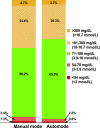Closing the Loop on Managing Youth With Type 1 Diabetes: Children Are Not Just Small Adults
- PMID: 29936422
- PMCID: PMC6054496
- DOI: 10.2337/dci18-0003
Closing the Loop on Managing Youth With Type 1 Diabetes: Children Are Not Just Small Adults
Abstract
As hybrid closed-loop (HCL) insulin delivery systems permeate clinical practice, it is critical to ensure all with diabetes are afforded the opportunity to benefit from this technology. Indeed, due to the suboptimal control achieved by the vast majority of youth with type 1 diabetes (T1D), pediatric patients are positioned to see the greatest benefit from automated insulin delivery systems. To ensure these systems are well poised to deliver the promise of more targeted control, it is essential to understand the unique characteristics and factors of childhood. Herein, the developmental and physiological needs of youth with T1D are reviewed and consideration is given to how HCL could address these issues. Studies of HCL technologies in youth are briefly reviewed. As future-generation closed-loop systems are being devised, features that could make this technology more attractive to youth and to their families are discussed. Integration of HCL has the potential to minimize the burden of this chronic medical condition while improving glycemic control and ultimately allowing our pediatric patients to fulfill the primary goal of childhood, to be a kid.
© 2018 by the American Diabetes Association.
Figures


References
-
- Miller KM, Foster NC, Beck RW, et al. .; T1D Exchange Clinic Network . Current state of type 1 diabetes treatment in the U.S.: updated data from the T1D Exchange clinic registry. Diabetes Care 2015;38:971–978 - PubMed
-
- Sullivan-Bolyai S, Deatrick J, Gruppuso P, Tamborlane W, Grey M. Constant vigilance: mothers’ work parenting young children with type 1 diabetes. J Pediatr Nurs 2003;18:21–29 - PubMed
-
- Sundberg F, Forsander G. Detection and treatment efficacy of hypoglycemic events in the everyday life of children younger than 7 yr. Pediatr Diabetes 2014;15:34–40 - PubMed
-
- Peters A, Van Name MA, Thorsted BL, Piltoft JS, Tamborlane WV. Postprandial dosing of bolus insulin in patients with type 1 diabetes: a cross-sectional study using data from the T1D Exchange Registry. Endocr Pract 2017;23:1201–1209 - PubMed
Publication types
MeSH terms
Substances
Grants and funding
LinkOut - more resources
Full Text Sources
Other Literature Sources
Medical
Research Materials

